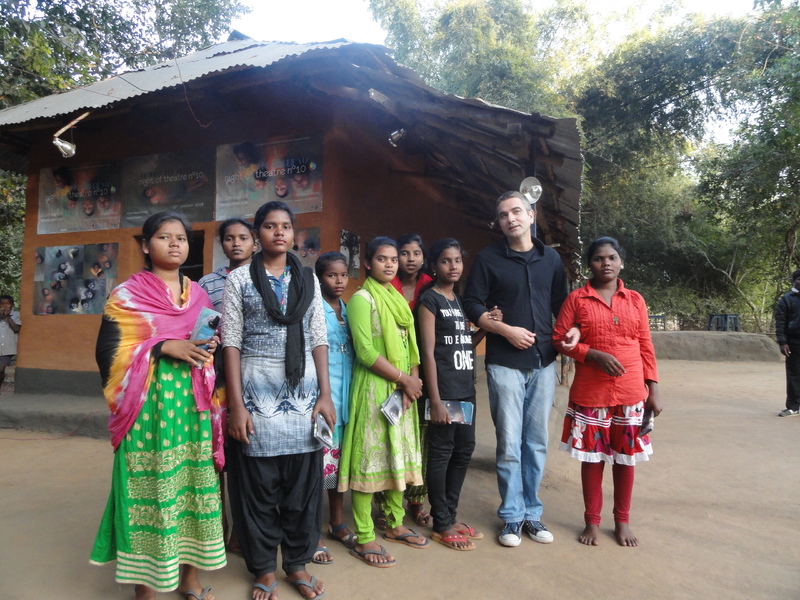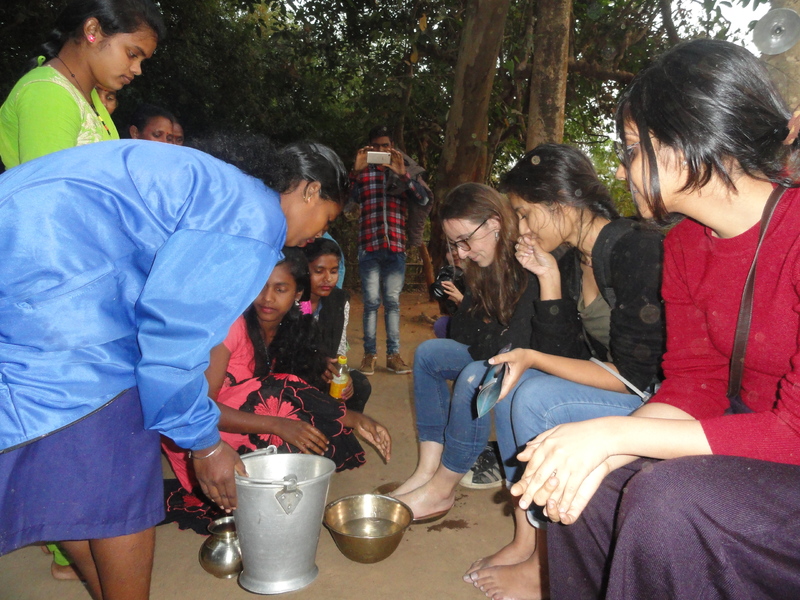Dublin Core
Title
Between the Avant-garde and the Traditional: The Question of Re-vitalizing Tribal art
Debashis Bandyopadhyay
Subject
Description
It began after sundown in Borotalpada, a remote Santhali village in the district of Jhargram in West Bengal, India. It seemed one has come to the end of the world. A dusky path lined on either side with sal and mahua trees opened onto a sort of escarpment. A pool of water stood on its edge and beyond it a long weir slope rose sharply from the ground. It was the setting for Trimukhi Platform’s avant-garde production, “Jol i Jibon” (Water is Life), with all Santhali cast, on January 27, the tenth anniversary of the ensemble’s project called “Night of Theatre”.
Trimukhi is the brainchild of Jean-Frederic Chevallier, a professor of Philosophy at the University of Sorbonne, Paris. It is imperative to reflect upon the objective of the project. Is it an attempt to initiate a community of people to a different culture altogether, or a quest to revitalize the cultural life of an indigenous community by adopting experimental artifices primarily developed in the West? The socio-economic fallout on the life of the affected community hinges on finding an answer to the question. Of course the benefactor too is benefited, not in any financial way but in the form of qualitative enrichment of his experiences.
The place, play-method, the cast and the director’s engagement are good indicators to go by. Upon the water of the pool, that barely rises to the heel, a flat wooden table flanked by footstools on either side comprise what can be called the centre of performance. On the escarpment close to the water line sit the stage hands, doubling as a multilingual (Santhali, Bengali, English and French) chorus. The decor is spartan yet hardwired. The mise-en-scene becomes complete with a hand-held loudspeaker, a laptop computer that does minimum of digital storyboarding and battery powered torches that train on the dark figures performing in black water. A dusky silhouette dissolves the split between the sky and the earth.
The story begins – as much as an absurdist piece of work has a story – with voices in the chorus recounting a version of the Santhali myth of origin. At the beginning the sky and the earth were inseparably together. When the primitive people of the stock accumulated vice and strayed from the ordained path, the sky, the abode of the gods, fell away and receded to where it is now. The narrative can be traced back to P. O. Bodding’s collection of Santhali folktales and exists in the form of a frame narrative in Tarashankar Bandyopadhyay’s Bengali novel, Kalindi.
A soft music plays on the computer as two characters emerge out of the darkness, careening over the water surface in a style Santhali women rummage water beds for food. The performance is a blend of mime and acrobatic movements (especially upon the wooden frame placed in the middle of the pool), including jigs and pratfalls in cold water. Words are scant and articulations resemble pure sounds. The movement of bodies strive to lend expressionist meaning to a sort of anthropological distance the Santhali lifeworld has traversed and is likely to wade further into the days of globalization. An apprehension of complete acculturation shows through the little bit of slapstick that is thrown in an otherwise hermetic production. There are chances that people might read in the sign an invitation to do away with all ethnic specificities under the exotic charm of the tinsel.
A fine-grained avant-garde performance collapses the hierarchic arrangement of space in traditional theatre and places the performers, the audience and the surroundings on a horizontal plane in equal terms of relationality. Antonin Artaud, the French pioneer of the form, envisioned the nuances of what he called the body without organs (BoW). If the superficial acts of everyday life are suggested by the movement of the body parts, the primordial spirit that vitalizes the undifferentiated universe is symbolized by the organ-less mass of the body. The cast in Chevallier’s play on the wooden platform mould their bodies into the gestalt of that elementary force. All variations of movement suggesting anthropological moments of cultural evolution tend to blend with the singular motif of this BoW. It constantly acts as a subtle reminder to the beginning time of the origin myth suggested by the choric raconteur. As a meta-theatrical device, however, it also serves to augment belief in the slapstick as a deterritorializing metaphor.
Gilles Deleuze, the postmodern French philosopher, finds Artaud’s idea of the BoW realized upon what he calls the “plane of immanence”. It is a space in which intense forces manifest in complex network of connections just like the movements crossing each other in myriad ways on the wooden board of Chevallier’s stage. The characters do not become performers any more than shamans live the primordial forces in a non-oppositional connection with the world.
Armchair philosophy is not Chevallier’s forte. A penchant for living it and expressing it through a persuasive form has brought him to adopt a nook in a Santhali village and translate the Santhali worldview into cerebral art. Someone with a refined aesthetic sensibility will be stirred by a feeling sublime in nature and cosmic in proportion. The young Santhali boys and girls who comprise the cast are being trained in the rudiments of the art form and are taught the meaning that they require to deliver.
But deliver to whom and at the cost of what? The performance is a little too radical in its disjunction with the specific nuances of the traditional cultural texts of the Santhali community. If they require to connect more substantially with audience from their own community and other tribal communities originating from the same stock and with whom they share cultural and geographical contiguity, more familiar elements require to be incorporated. The question is to what extent such an avant-garde form can manage to accommodate tradition. Not that there is no scope for it. For example, the digital scores that accompany this performance are not only aberrations at places but also distant from anything that the community ever made use of in their ethnic rites and festivals. Conspicuous is the absence of the sound of the madal (a favourite percussion instrument of the community). It is particularly connected according to Kherwal (the Austro-Asiatic stock from which the Santhals descended) folklores with the sacred dong music that emanated from the water of the fountain consecrated to the Santhali Muse. The sound dong is said to ruffle waters of a still pool and lend intensity and vitality to the community’s life. Wisely employed, it could not have been irrelevant to the aquatic aura and theme of the performance. The rhythm, melodies and even lyrics of such adivasi performances as Langre, Danshay, Sorhay and Vandan could have fused well with the text of the performance and ensured greater comprehensibility to the audience within the community.
Scholars devoted to tribal studies feel concerned about the future of traditional art forms. Unless they are given a modern touch and some of the hackneyed shades are done up, it would be difficult to secure these pieces as living art forms. An endeavour like that of Chevallier could be extremely significant in that way. But a radical departure from the traditional forms would pose a cultural threat to their ethnic identities.
Trimukhi, however, is absolutely free to have their way: take the avant-garde forms to urban audiences and attract the latter to the peripheral Santhal village. A platform to that effect is created. City people will journey as far to discover that there is more to Santhal cultural ethnicity than meets the eye in Trimukhi’s customised repertoire meant for the city centres. But let them not conclude that all such “excesses” are redundant.
Chevallier and his team are perfectly capable of ensuring that. The art village in Bortalpada supports and nurtures the artistes in their ritual performances. The young cast wash the bare feet of their guests with water and oil in the tradition of the welcoming ritual called lota da. Among the medley of performances they present through the night are a couple of traditional Santhali dances accompanied by dhol and madal. Jean-Frederic’s wife Sukla and a Japanese avant-garde artiste Ikue Nakagawa have introduced modern innovations to the traditional forms. Connoisseurs of tribal art have come forward to collaborate with Trimukhi with the objective of restoring the endangered forms.
Girish Soren was a young boy during the early days of Trimukhi in 2009. He had learnt the techniques of experimental art and helped create the mud-swell and the marquee that form the Platform’s courtyard in Barotalpada. Now a civic volunteer in the district town, he seldom finds time for such performances. “Had it been a more adivasi affair in a broader sense’’, says he “we could have naturally been inducted into the carnival”. Now, if the collaborative venture takes off, Soren’s dreams are expected to come true.


